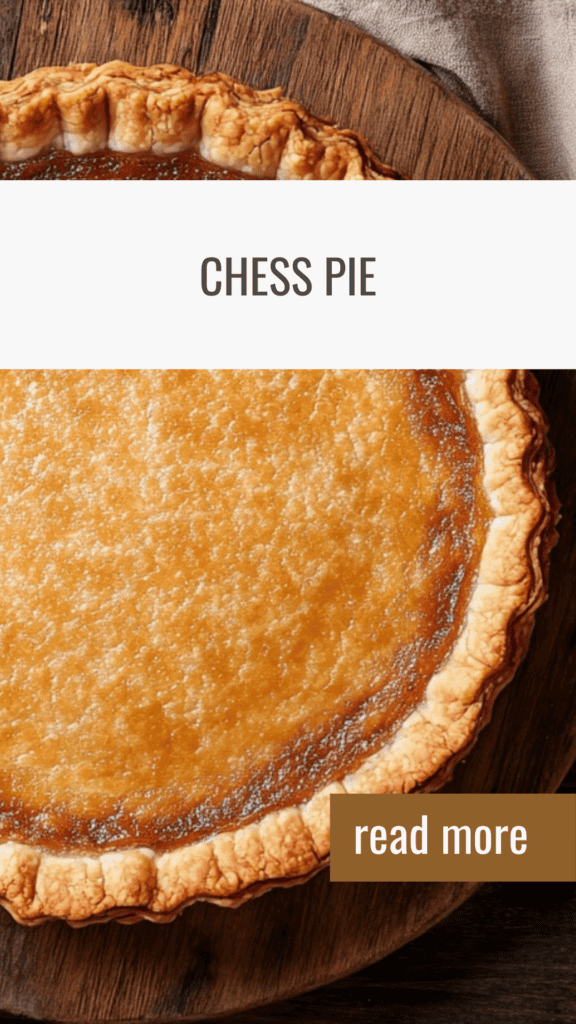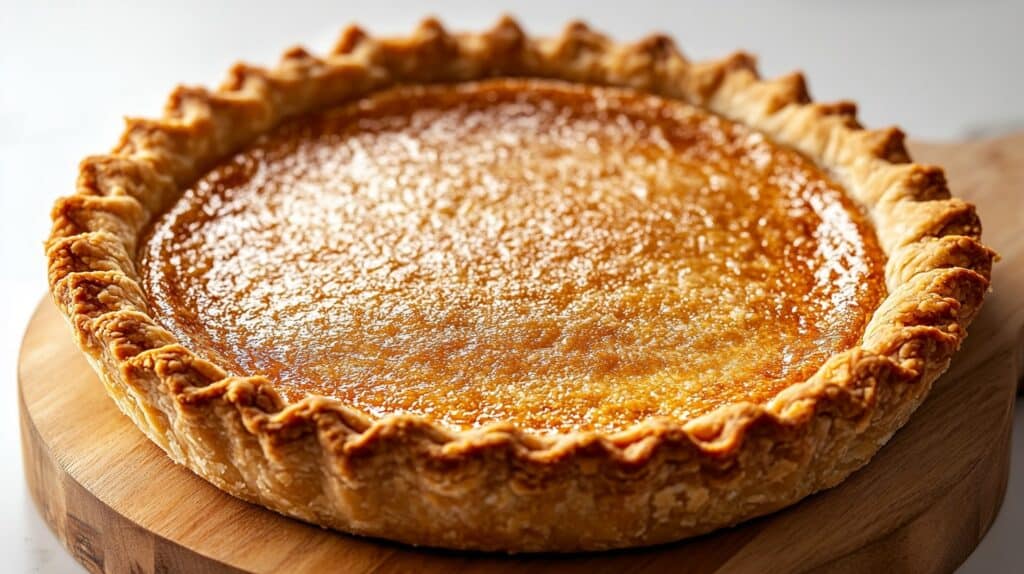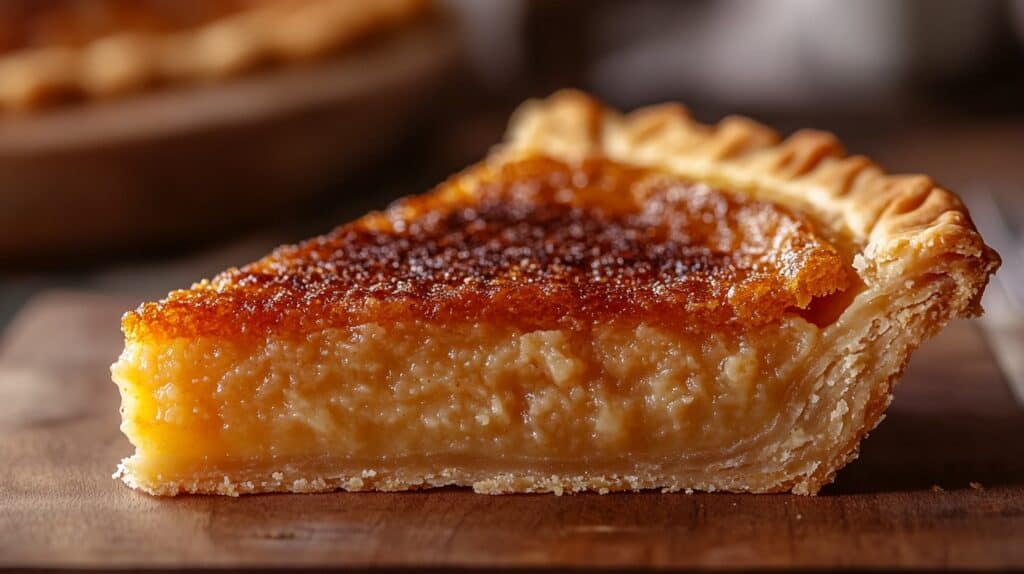Chess pie is one of those desserts that feels like it has always been around. It’s simple, straightforward, and doesn’t require any fancy ingredients. The filling is made with butter, sugar, eggs, and a few other pantry staples, baked in a flaky pie crust. The result is a custard-like texture with a slightly crisp top, perfect for slicing and serving.
This pie has a long history, especially in the South, where it has been passed down for generations. It’s not a pie that relies on seasonal ingredients or special techniques, which is part of what makes it a reliable favorite. Whether you’ve had it at a family gathering or never tried it before, chess pie is worth making at home.

The Origins of Chess Pie
The exact origin of the name “chess pie” isn’t clear. Some say it comes from the phrase “just pie,” with a Southern accent making it sound like “chess pie.” Others suggest it was named after an old type of pie chest, where baked goods were stored. No matter where the name comes from, the pie itself is a staple in many homes, especially in the South.
Chess pie is similar to other custard-based pies, but it has a few ingredients that make it unique. The addition of cornmeal helps the filling set, giving it a slightly firmer texture than a typical custard pie. The vinegar adds balance, cutting through some of the sweetness to keep the flavor from being too rich.
Why Chess Pie Stands Out
One of the reasons chess pie has remained popular is its simplicity. It doesn’t require fresh fruit, nuts, or chocolate—just a handful of ingredients most people already have in their kitchen. The recipe is forgiving, making it a great choice for beginner bakers. Since it doesn’t depend on delicate techniques, it’s hard to mess up.
Another reason people love this pie is its versatility. It can be served warm or cold, plain or topped with whipped cream. Some people even like to dust it with powdered sugar. No matter how you serve it, chess pie is a reliable option for any occasion.

Key Ingredients in Chess Pie
Understanding the role of each ingredient helps explain why this pie works so well.
- Sugar – The base of the filling, giving the pie its characteristic sweetness.
- Butter – Adds richness and helps create a smooth texture.
- Eggs – Essential for setting the filling, giving it structure and stability.
- Cornmeal – The ingredient that makes chess pie unique, helping it set while adding a slight texture.
- Flour – Works with the cornmeal to thicken the filling.
- Milk – Adds moisture and helps balance the texture.
- Vinegar – A small amount adds contrast, keeping the pie from being overly sweet.
- Vanilla Extract – Rounds out the flavor and enhances the sweetness.
Each ingredient plays a role, and when combined, they create a smooth, custardy filling that bakes into something greater than the sum of its parts.
I love using a cast iron pie pan, but any pie pan will work.

Tips for Making the Best Chess Pie
Even though chess pie is simple, there are a few things to keep in mind to make sure it turns out just right.
- Use room-temperature eggs – This helps them mix evenly into the filling, preventing any separation.
- Melt the butter and let it cool slightly – If it’s too hot, it could scramble the eggs when mixed in.
- Whisk the filling well – Everything should be smooth before pouring it into the crust.
- Bake until just set – The center should jiggle slightly but not be liquid. Overbaking can cause the filling to crack.
- Let the pie cool completely – This allows the filling to firm up, making it easier to slice.
Serving and Storing Chess Pie
Chess pie can be served at room temperature or chilled. Some people prefer it plain, while others like to add a topping. Whipped cream is a popular choice, but powdered sugar or fresh berries can also complement the pie.
Once baked, chess pie can be stored at room temperature for a day, covered loosely. If you need to keep it longer, store it in the refrigerator for up to four days. The pie also freezes well—just wrap it tightly and freeze for up to three months. To serve, let it thaw in the fridge overnight.

Variations of Chess Pie
While traditional chess pie is made with a basic custard filling, there are a few variations that people like to try.
- Lemon Chess Pie – Adds fresh lemon juice and zest for a bright, citrusy flavor.
- Chocolate Chess Pie – Includes cocoa powder to give it a rich, chocolatey twist.
- Coconut Chess Pie – Shredded coconut is mixed into the filling for extra texture.
- Brown Sugar Chess Pie – Uses brown sugar instead of white sugar for a deeper, caramel-like flavor.
Each version sticks to the same basic recipe but offers a slightly different take on the classic.
Why You Should Try Making Chess Pie
If you’ve never made chess pie before, it’s worth trying at least once. It’s a pie that doesn’t require much effort but delivers big results. Whether you’re making it for a family gathering or just for yourself, it’s a dessert that’s easy to put together and always turns out well.
Because it uses simple ingredients, it’s also a great last-minute dessert. If you need to make something quickly but don’t have time to run to the store, there’s a good chance you already have everything you need to make chess pie.
Final Thoughts
Chess pie is a timeless dessert that’s been around for generations, and for good reason. It’s easy to make, uses basic ingredients, and delivers a rich, satisfying flavor. Whether you stick with the classic version or try a variation, it’s a pie that’s worth keeping in your recipe collection.
If you make chess pie, you’ll see why it has remained a favorite for so long. It’s a dessert that doesn’t try too hard but always delivers. And sometimes, that’s exactly what you need.
PrintChess Pie
A classic Southern dessert with a rich, buttery, and slightly tangy filling baked in a flaky crust.
Ingredients
For the crust:
- 1 1/4 cups all-purpose flour, plus more for dusting
- 1/2 teaspoon salt
- 1/2 cup (1 stick) cold unsalted butter, cut into cubes
- 1/4 cup cold vegetable shortening, cut into cubes
- 1/4 cup ice water
For the filling:
- 1 cup granulated sugar
- 1 tablespoon cornmeal
- 1/4 teaspoon salt
- 1/2 cup (1 stick) unsalted butter, melted
- 2 large eggs
- 1 teaspoon vanilla extract
- 1/2 cup whole milk
- 1 tablespoon apple cider vinegar
Instructions
- Make the crust: In a large bowl, whisk together the flour and salt. Cut in the butter and shortening using a pastry blender or your fingertips until the mixture resembles coarse crumbs. Gradually add the ice water, a tablespoon at a time, mixing until the dough just comes together. Form the dough into a disk, wrap in plastic wrap, and refrigerate for at least 30 minutes.
- Preheat the oven to 350°F (175°C). On a lightly floured surface, roll out the dough to a 12-inch circle. Transfer the dough to a 9-inch pie plate. Trim and crimp the edges.
- Make the filling: In a large bowl, whisk together the sugar, cornmeal, and salt. Stir in the melted butter. Beat in the eggs one at a time, then stir in the vanilla extract, milk, and apple cider vinegar.
- Pour the filling into the prepared pie crust. Bake for 45-50 minutes, or until the crust is golden brown and the filling is set but still slightly jiggly in the center.
- Let the pie cool completely on a wire rack before slicing and serving. The filling will firm up as it cools.
Notes
- For a richer flavor, you can use brown butter in the filling. To make brown butter, melt the butter in a saucepan over medium heat, swirling occasionally, until it turns a nutty brown color and has a fragrant aroma.
- The apple cider vinegar adds a subtle tang that balances the sweetness of the pie. Don’t skip it!
- If the crust edges brown too quickly, cover them with strips of aluminum foil.
- This pie is best served at room temperature or slightly warm.